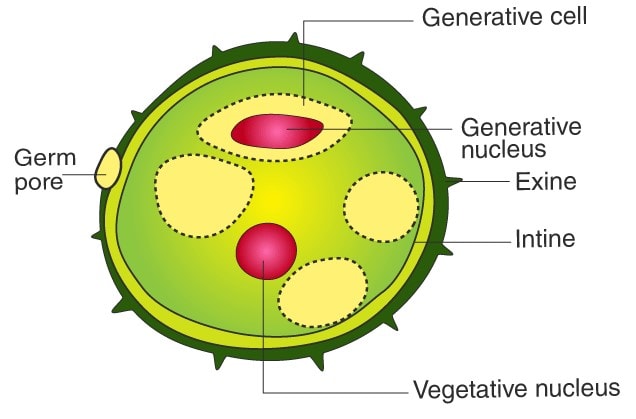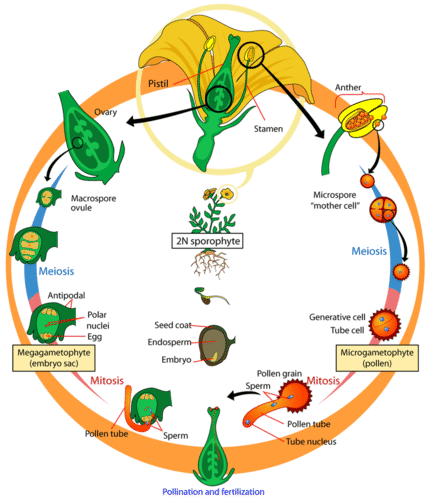Easy 7th Grade Cycle of Angiosperms Easy 7th Grade Cycle of Gymnpsperms
The term Angiosperms come from the Greek words angeion ("vessel") and sperma ("seed") and refers to the plants which produce their seeds enclosed within a fruit.
Check out awesome, educational VR rooms on Inspirit's mobile app (available for iOS and Android devices)🤩
Introduction:
Angiosperms are flowering plants — one of the vital groups of plants with seeds inside themselves. Angiosperms represent approximately 80% of all the known green plants now living.
Explain the reproduction process of angiosperms.
 Source
Source
Reproduction in flowering plants starts with pollination, the transference of pollen from anther to stigma on the same flower or the stigma of another flower on the same plant known as self-pollination or from the anther on one plant to the stigma of another plant known as cross-pollination.
Angiosperms Life Cycle: Facts
First Stage:
- Sporophyte generation controls all the vascular plants' life cycles. (All plants have a cycle in which they undergo alternation of generations. This process involves haploid multicellular generation called a gametophyte and diploid multicellular generation called the sporophyte. Haploid means having only one set of chromosomes written as 'n' and diploid means having two sets of chromosomes written as '2n'.)
- The sporophyte (diploid multicellular generation) phase or the adult phase is an important process of an angiosperm's life cycle comprising the first stage.
- It is also known as the adult phase, and gymnosperms and angiosperms are heterosporous.
- They generate microspores, that will produce pollen grains as the male gametophytes, and megaspores, which will form an ovule that contains female gametophytes. It is one of the two alternating multicellular phases in the life cycle of the plants.
Second Stage:
- In the second stage of the angiosperm life cycle, the generation of haploid microspores occur inside the anther, microsporangia and male gametophytes are divided by meiosis. This in return undergoes mitosis, and pollen grains rise. Microsporangia are sporangia that produce microspores which give rise to male gametophytes at the time of germination.
- Among both cells, one is the generative cell divided into two sperm parts, and after that, the second cell generates with the pollen tube cells.
- Megasporangium is present inside the ovule, sheltered within the ovary of the carpel and it is protected by two layers of integuments and the ovary wall. With every megasporangium, a megaspore undergoes meiosis which generates four megaspores.
- The meiosis process occurs in the megasporangium, generating one large megaspore and three small megaspores. Meiosis is the process where a single cell divides twice to produce four cells.
- In all these megaspores, the large one survives, and it produces the female gametophyte which changes into an embryo sac.
- The megaspore divides three times to form an eight-cell stage.
Third Stage & Final Stage:
- The migration process of the cells starts in the final stage of the angiosperm life cycle. Out of the eight cells, four cells shift towards the embryo sac pole; two move to the equator and ultimately fuse to form a 2n polar nucleus.
- A grown-up embryo sac has a single egg cell and a couple of helping cells known as synergids.

- Only the mature embryo sac has a single egg cell and two synergids ("helper" cells), three antipodal cells, and two polar nuclei cells in a central cell.
- Once the pollen grain reaches the stigma, a pollen tube extends from the grain and enters via the micropyle, an opening to the ovule's integuments.
- Inside the embryo sac, two sperm cells are deposited. Thus, the process of double fertilization starts after the deposition of sperm cells takes place in the embryo sac, and the future embryo is formed by the combination of an egg and sperm.
- The endosperm is formed when the other sperm (the second sperm) combines with the 2n polar nuclei. The endosperm is tissue that acts as a food reserve.
Conclusion:
In our daily life, angiosperms are commonly found!
- The vascular seed plants in which an egg is fertilized and developed into a seed in an enclosed hollow ovary are called angiosperms. The trees of fruits are the most common examples of angiosperms.
- Different types of flowers appear on the branches of the trees before they are turned into fruits. A few examples of such trees are oranges, apples, and cherries.
- Varieties of insects and mammals pollinate trees of these fruits. After the process of pollinators come to an end, the carpel of the plant starts swelling, and thus they get turned into fruits, and sometimes the colors of the fruits are changed.
- It is commonly known that grass crops like rice and wheat cannot draw the interest of animals for pollination, so they mainly depend on the wind for pollination. Seeds of these grasses are so light in weight which helps them to spread easily with the help of wind.
FAQs:
1. What are the 5 stages of a life cycle in the flowering plant?
The 5 stages are Sprout, Seedling, Vegetative, Budding, Flowering, Ripening. These are the stages of the life cycle in flowering plants.
2. What is the life cycle of gymnosperms and angiosperms?
The adult or sporophyte phase is the main phase of an angiosperm's life cycle. As with gymnosperms, angiosperms are heterosporous.
3. What is unique in the life cycle of angiosperms?
Double fertilization is a process unique to angiosperms; the ovule sheltered within the ovary of the carpel contains the megasporangium protected by two layers of integuments and the ovary wall.
4. How does pollination of angiosperms take place?
In angiosperms, pollination is defined as the transfer of pollen from the anther to the stigma of the same flower or another flower.
5. How is embryo formed in angiosperms?
The young plant in the seed begins as a developing egg-cell formed after fertilization and becomes a plant embryo.
6. What is the reproductive part of angiosperms?
The reproductive part of the angiosperms is located in a flower.
7. What happens after fertilization in angiosperms?
After fertilization, the fertilized ovule forms the seed while the ovary tissues become the fruit.
We hope you enjoyed studying this lesson and learned something cool about Life Cycle of Angiosperms! Join our Discord community to get any questions you may have answered and to engage with other students just like you! Don't forget to download our App to experience our fun, VR classrooms - we promise, it makes studying much more fun! 😎
Sources:
- Life Cycle of Angiosperms. https://flexbooks.ck12.org/cbook/ck-12-biology-flexbook-2.0/section/9.21/primary/lesson/angiosperm-life-cycle-bio/ Accessed 10 Dec, 2021.
- Plant Life Cycles Study Guide. https://flexbooks.ck12.org/studyguides/biology/life-cycle-plant-life-cycles-study-guide.html?encodedID=SCI.BIO.654&courseContextID=5292077. Accessed 10 Dec, 2021.
Source: https://www.inspiritvr.com/general-bio/plants/life-cycle-of-angiosperms-study-guide
Postar um comentário for "Easy 7th Grade Cycle of Angiosperms Easy 7th Grade Cycle of Gymnpsperms"